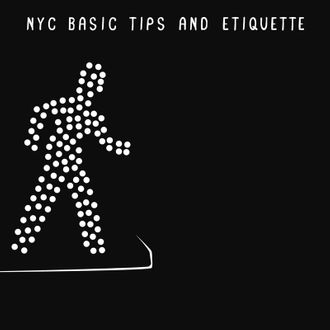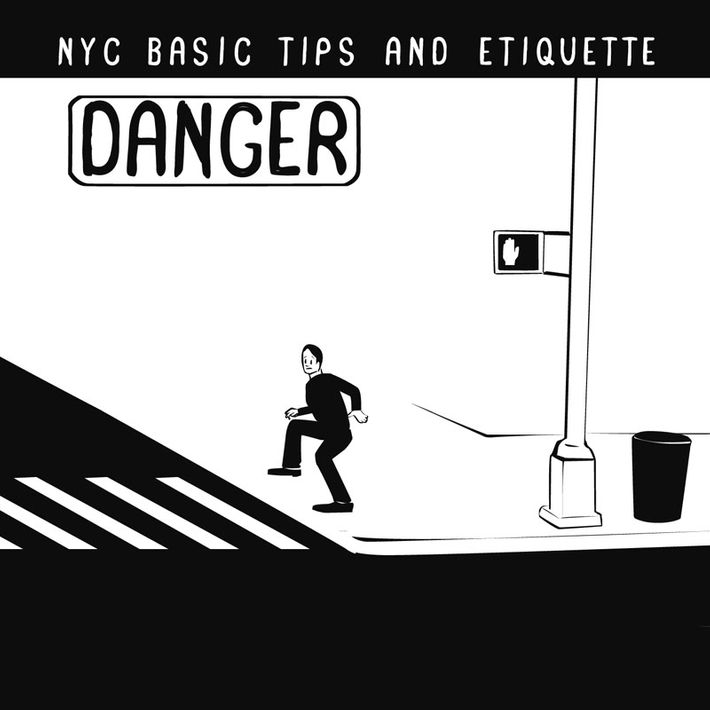
New Yorkers — perpetually rushed and just a bit obstinate by nature — jaywalk instinctively, it seems. The act is as natural a part of living here as riding the subway and waiting on (instead of in) line. But like many things, there’s a right way and a wrong way to do it.
As the city tallied a startling twelve pedestrian deaths in the first few weeks of the year, Mayor Bill de Blasio announced a new focus on pedestrian safety, something that lagged during Mayor Michael Bloomberg’s reign. That new focus has taken various forms, from the NYPD deputy inspector cracking down on scofflaw drivers in Park Slope to the far more controversial increase in jaywalking tickets citywide. De Blasio has said there is no coordinated crackdown on jaywalking, but that local precinct commanders are free to enforce the law as they please. In the Upper West Side earlier this month, one such crackdown led to a bloody scuffle between police and the 84-year-old jaywalker they were ticketing. He’s now suing.
Since then, jaywalking has been a hot topic. In the Village, some NYU students created a special crosswalk signal that lectures people about pedestrian safety. ABC’s Brian Ross hit someone who was crossing against the light just this week. And outlets such as the Associated Press and Los Angeles Times have taken to marveling at New Yorkers’ street-crossing brazenness.
Nobody is going to tell residents and workers of this city not to jaywalk. But this might be a good time to offer up a few reminders about how to do it safely and effectively, especially with hoards of people flowing in for the Super Bowl. We spoke with transportation engineer and former city Traffic Commissioner “Gridlock” Sam Schwartz, as well as cycling and pedestrian activist Keegan Stephan, an organizer with the group Right of Way, about how the savvy New Yorker jaywalks.
Why does everybody in this city jaywalk, and why is that okay?
“New Yorkers don’t like to be told what to do. We’re in a hurry and we know the shortest distance between two points is a straight line,” Schwartz said. “And I’m not so sure it’s that bad. There is a school of traffic engineering, best exemplified by a Dutch engineer Hans Monderman, who said we’re going about it the wrong way in our cities by trying to set up a lot of rules and regulations. In fact, the pedestrian should rule.”
Monderman advocated removing most road signs, on the theory that cars and pedestrians would instinctively navigate around one another if they knew to be on the lookout. A favorite trick of his was to walk into traffic backwards or blindfolded. “He was never hit by a car but unfortunately he died of a heart attack,” Schwartz said, perhaps from the stress of walking into traffic blindfolded. Anyway, “that’s a school of thought that I partially subscribe to: A little bit of chaos isn’t that bad. It slows down traffic and reduces the probability of fatalities.”
Can jaywalking ever be safer than waiting for the light?
“There’s definitely an argument to be made that it’s safer to cross when there’s a ‘don’t walk’ signal because that way you can be sure no car’s going to be making a turn,” Stephan said. Given the city’s ban on right turns on red, cars looking to make a turn will be waiting for the same light as pedestrians. And since they’re waiting behind the lines of the perpendicular crosswalk, they can be hard to see, then they race to make the turn ahead of the pedestrians, Stephan explained. “I do memorialize a lot of pedestrians who are killed, and that’s something we see all the time. I did eight recently, and in six of them the drivers were making a turn.”

Schwartz concurred: “I think each one of these is an independent decision. But it is true that a 2010 study of five years of crashes found that about half of pedestrians hit were crossing at crosswalks with signals, and more than half of those were obeying the signal. Most of those killed while obeying walk signals were hit by turning vehicles.”
So what behavior makes for safe (or unsafe) jaywalking?
Beware of tall trucks: “I say don’t cross until you see the whites of their eyes,” Schwartz said. That means don’t cross late in the walk signal in front of a stopped truck, whose driver may suddenly look up, see a green light, and gun it. They may not even realize they’ve hit someone when that happens. It also means that when crossing mid-block, don’t start from behind a tall vehicle. “If you’re stepping out mid-block between parked cars, and one of those cars is larger than most vehicles, it can block the line of sight,” Stephan said.
Don’t lead off: “We love to stand three or four feet into an intersection and watch cars turning in front of us,” Schwartz says. “If a car turns in front of you and the front doesn’t hit you, the back won’t hit you. But if a truck crosses in front of you, the rear wheels of a tractor-trailer do not follow the same path as the front. I have measured it at a more than seven-foot difference. The rear comes seven feet closer to the curb. The front goes past you and you’re not worried, and you’re looking at your phone, and then the rear wheels come by and sucks you under.”
That goes extra for parents: “If your child is in a stroller or carriage, don’t push them in front of you as you peer out to see if there’s any traffic,” Schwartz said. “That means they’re two, three, four feet out in front of you, and you didn’t even check to see if there’s traffic. Don’t have your carriage be the first thing that enters traffic if you can’t see the traffic.”
Beware of mirrors: “One of the problems we have now is that the mirrors protrude way beyond where they were 30 years ago,” Schwartz said. Now, vehicle manufacturers have no compunction about adding another six inches on cars, and a foot on trucks. So the front of the vehicle passes you safely but then you get hit by the mirror. The young doctor who was killed on 96th Street, [a mirror] sent her reeling into traffic and then she was killed.”
Watch the weather: “The highest fatality times are when the driver has the least visibility and traction,” Schwartz said. “It’s dark, it’s rainy, could be snowy, ice on the ground. The pedestrian doesn’t want to be outside and is trying to get to a warm place. They’re maybe wearing a hood. When you cross the street, flip back that hood and look all around.”
And the time of day: “I also say that when it gets dark your antenna should go up,” Schwartz said. “You’re many times more likely to be killed crossing a street when it’s dark. Assume that the person at the wheel of the car is drunk, and you’ll stand a much better chance of getting to the other side.”
Pay attention to the asphalt: “When the road surface is compromised, I think that’s something savvy jaywalkers look out for,” Stephan said. “A pothole that can catch your heel or even oil on the ground that could be slick. You don’t want anything slowing you down when you’re crossing against the light.”
Don’t ignore traffic: “I see this in particular in midtown: If you see the cars have stopped, and you still have the ‘don’t walk’ signal, watch out because it means someone else has a green,” Schwartz says. “So in midtown, for example, a left-turn lane may have to stop, but the straight-through has a green arrow. So to be a savvy walker, understand how traffic signals work. If you don’t have the “walk,” it means someone definitely has a green light to cross your path.”
When should one never jaywalk?
“Whenever you’re at a location in which you have two (or more) two-way streets meeting each other. That means that there are twelve different movements that could occur by motor vehicles. It’s just too much for anyone. So at Park and 57th, even Gridlock Sam waits to get the walk signal.”
Illustrations by Nathan Pyle, whose book NYC Basic Tips and Etiquette is out in April.





























